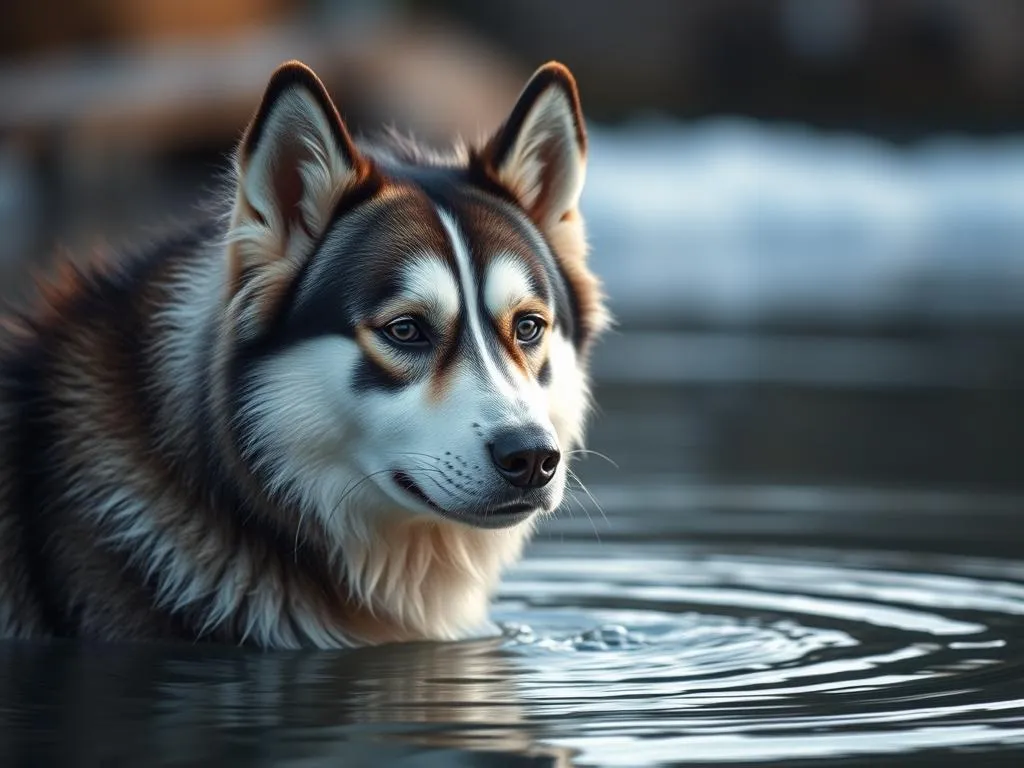
The Siberian Husky is one of the most beloved dog breeds, known for its striking appearance and energetic demeanor. These dogs have captured the hearts of many pet owners, but their affinity for water remains a topic of curiosity. Do Huskies like water? The answer isn’t straightforward and depends on various factors, including their natural instincts, training, and individual personalities.
Understanding the Siberian Husky
History and Origin
The Siberian Husky originated from the Chukchi people in Siberia, where these dogs were bred for their endurance and ability to pull sleds over long distances in harsh climates. Their history is deeply intertwined with Arctic communities, where they served as vital companions and working dogs. This lineage has endowed them with remarkable stamina and a thick, double coat that helps them thrive in cold conditions.
Physical Characteristics
Huskies are medium-sized dogs, typically weighing between 35 to 60 pounds, with males being larger than females. They have a well-proportioned body, erect triangular ears, and striking blue or multi-colored eyes. Their double coat is designed to keep them warm in frigid temperatures, but it also means they can be sensitive to heat. This physical makeup can influence their behavior around water, especially in different climates.
The Natural Instincts of Huskies
Instinctual Behaviors
Huskies possess strong predatory instincts, which can affect their relationship with water. Unlike retriever breeds that were bred for waterfowl hunting, Huskies were primarily bred for pulling sleds. This means their instinctual behaviors do not necessarily include water-related activities. However, their natural curiosity and playful nature might still lead them to explore water environments.
When compared to other breeds, such as Labradors or Golden Retrievers, Huskies may not exhibit the same enthusiasm for swimming. This difference can be attributed to their unique history and purpose as sled dogs rather than water dogs.
Swimming Ability
Despite their lack of a strong water instinct, many Huskies are natural swimmers. Their athletic build and powerful legs allow them to paddle efficiently. Anecdotal evidence suggests that some Huskies enjoy swimming and can be quite adept at it, particularly if they are introduced to water at a young age. Studies on canine swimming capabilities indicate that most dogs, including Huskies, can swim instinctively, but their enthusiasm for it may vary.
Do Huskies Like Water?
General Behavior Towards Water
Observations of Huskies interacting with water can provide insight into their preferences. While some Huskies may eagerly jump into lakes or pools, others may be more hesitant. Factors influencing whether a Husky likes water include:
- Early exposure: Huskies that are introduced to water as puppies are more likely to enjoy it later in life.
- Temperament: Individual personalities play a significant role; some Huskies may be naturally adventurous, while others are more cautious.
Individual Variability
It’s crucial to recognize that not all Huskies will react the same way to water. Individual variability can be significant within the breed. Some Huskies may love splashing around in the water, while others may prefer to stay on dry land. This variability underscores the importance of early socialization and positive experiences with water, which can foster a more favorable attitude towards it.
Factors Influencing a Husky’s Relationship with Water
Temperature and Environment
The temperature and environment can greatly influence a Husky’s enjoyment of water. In hot weather, a dip in a pool or lake can be refreshing and enjoyable for Huskies. Conversely, in colder climates, they may be less inclined to enter cold water due to their thick coats designed for insulation. The ideal water experiences for Huskies often involve warm weather, where they can cool off without feeling too cold.
Training and Socialization
Training and socialization play pivotal roles in a Husky’s relationship with water. Positive experiences with water during puppyhood can shape their attitudes towards swimming and water play. Here are some tips for encouraging a Husky to enjoy water:
- Start slowly: Introduce your Husky to shallow water first, allowing them to acclimate without feeling overwhelmed.
- Use toys: Incorporate their favorite toys to make the water more enticing.
- Be patient: Allow your Husky to explore at their own pace and never force them into the water.
Safety Considerations for Huskies Around Water
Supervision and Precautions
When allowing your Husky near water, supervision is critical. Huskies are known for their independent nature, which can lead them to wander off or get into trouble. Here are some safety precautions to keep in mind:
- Always monitor your Husky in or near water, especially in unfamiliar environments.
- Use a leash when necessary to prevent them from running off.
- Familiarize yourself with the area to identify potential hazards, such as strong currents or sharp rocks.
Health Concerns
While water can be a fun and refreshing experience for your Husky, there are health concerns to consider. Exposure to cold water can lead to hypothermia, particularly in young or elderly dogs. Here are some tips for ensuring your Husky’s health during water activities:
- Avoid swimming in very cold water, especially for extended periods.
- Rinse off your Husky after swimming to remove chlorine or saltwater, which can irritate their skin.
- Keep an eye out for signs of discomfort or distress while in the water.
Fun Water Activities for Huskies
Swimming and Fetching
Swimming and fetching are excellent activities for Huskies during the warmer months. Here are some best practices for teaching your Husky to swim:
- Demonstrate enthusiasm: Show your Husky how much fun water can be by playing and splashing around yourself.
- Use a life vest: Consider using a dog life vest for added safety, especially in deeper water.
- Play fetch: Tossing a ball or toy into the water can entice your Husky to swim and retrieve.
Water Parks and Dog-Friendly Beaches
Taking your Husky to water parks or dog-friendly beaches can be a fantastic way to socialize them and allow them to enjoy water safely. Here are a few benefits of these outings:
- Socialization: Interacting with other dogs can help improve your Husky’s social skills.
- Variety of environments: Different water settings provide new experiences that can enhance their comfort level around water.
- Fun for the whole family: These outings can be enjoyable for both you and your Husky, creating lasting memories.
Conclusion
The relationship between Huskies and water is nuanced and varies from dog to dog. While some Huskies may love to swim and play in the water, others may prefer to stay dry. Understanding the factors that influence a Husky’s affinity for water, including their history, individual temperament, and early experiences, can enhance their enjoyment of water activities.
As an owner, being attentive to your Husky’s needs and preferences is key to fostering a positive relationship with water. Exploring water activities with your Husky can lead to fun, bonding experiences that keep both of you active and engaged.
Whether your Husky loves to dive into the pool or cautiously approaches the shoreline, knowing their unique personality can help you create enjoyable water experiences tailored just for them.









